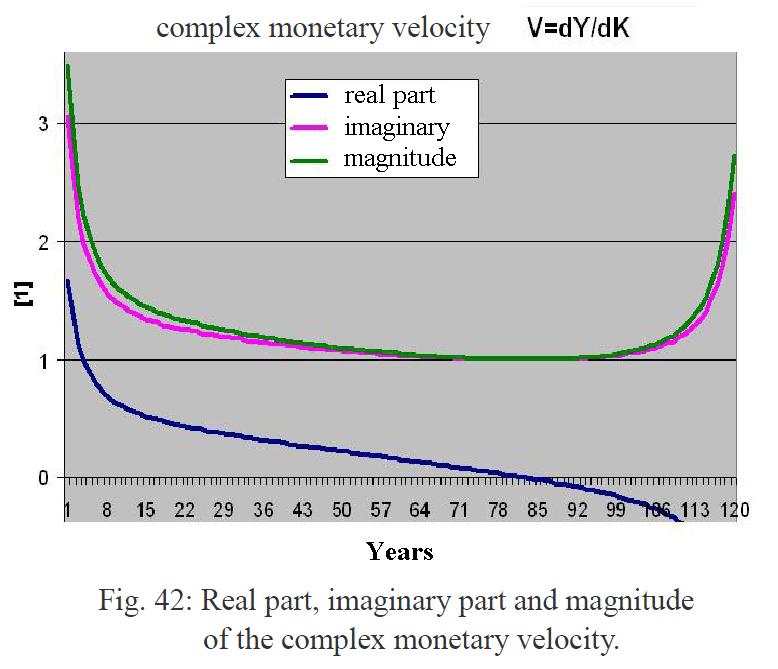45 Preservation of the Tangent Angle
First, we exploit the symmetry of
the constant tangent cutting angle![]() .
Our pole vector is
.
Our pole vector is![]() and thus the
tangent vector is
and thus the
tangent vector is![]() . Thus follows by
rule of the scalar-product
. Thus follows by
rule of the scalar-product
![]() (45.1)
(45.1)
from which follows now the 'economic Pythagoras' :
![]() (45.2)
(45.2)
Of this we can now solve the Euler-Lagrange equation:
![]() (45.3)
(45.3)
The results are the three solutions
![]()
![]() (45.4).
(45.4).
The importance of the first ![]() is trivial, it
simply states that if no growth takes place through capital investment, then
neither capital nor economy86 grows. The other solutions can be
resolved meaningfully related to the growth rate resulting from capitalization:
is trivial, it
simply states that if no growth takes place through capital investment, then
neither capital nor economy86 grows. The other solutions can be
resolved meaningfully related to the growth rate resulting from capitalization:
![]() (45.5)
(45.5)
The importance of the real part is that the
growth rate with respect to K decreases as![]() does. This means
that the marginal benefit of capital decreases as
does. This means
that the marginal benefit of capital decreases as ![]() with time, a fact
which is confirmed by the experience and was treated as part of the special
theory already. The amount of the complex vector
with time, a fact
which is confirmed by the experience and was treated as part of the special
theory already. The amount of the complex vector
![]() (45.6)
(45.6)
results to the two possible amounts:
![]() or
or
![]() (45.7)
(45.7)
The value![]() is now linked on the quantity equation with the average monetary
velocity:
is now linked on the quantity equation with the average monetary
velocity:
![]() , and thus
applies
, and thus
applies ![]() (45.8).
(45.8).
In the GMF, it proves useful, the correlation of Y with K in the complex plane to investigate. It is the complex vector
![]() (45.9)
(45.9)
the object of investigation. It now runs the
imaginary axis in the Y(K)-diagram along the vertical axis and the real
part along the horizontal x-axis. On the course of the real and
imaginary part of the solution![]() ,
we can already derive some properties for the average monetary velocity: Thus
we see the course of the imaginary part corresponding to the real economy
component, the typical U-shaped curve of the average velocity. Unlike the real
part that corresponds to the proportion of the capital stock, where the
velocity decreases and eventually becomes negative even.
,
we can already derive some properties for the average monetary velocity: Thus
we see the course of the imaginary part corresponding to the real economy
component, the typical U-shaped curve of the average velocity. Unlike the real
part that corresponds to the proportion of the capital stock, where the
velocity decreases and eventually becomes negative even.

Correspond to the empirical facts that could be observed as in the recent crisis that the banks due to lack of returns, no longer trusted each other. And therefore, funds withheld, instead of selling loans. The real economy on the other hand is stagnating first, but only then to re-tighten. Which can be explained by the fact that first the general economic situation warns the money to be restraint, but at the end of the growing crisis money will be exchanged increasingly into real values.
While the different development of the two
contributions![]() and
and![]() is clear, but in
the real economy, however, the sum of share is the load-bearing component. The
two solutions differ in little:
is clear, but in
the real economy, however, the sum of share is the load-bearing component. The
two solutions differ in little:
